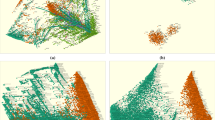Abstract
New web technologies led to the development of browser applications for data analysis. Modern browser engines allow for building interactive real-time visualization applications that enable efficient ways to understand complex data. We present Flow-Inspector, a highly interactive open-source web framework for visualizing network flow data using latest web technologies. Flow-Inspector includes a backend for processing and storing large-scale network flow data, as well as a JavaScript-based web application capable to display and manipulate traffic information in real-time. This work provides operators with a toolkit to analyze their networks and enables the scientific community to create new and innovative visualizations of traffic data with an extensible framework. We demonstrate the applicability of our approach by implementing several different visualization components that help to identify topological characteristics in network flows.









Similar content being viewed by others
Explore related subjects
Discover the latest articles, news and stories from top researchers in related subjects.References
(2012) Tools for Data Visualization. http://selection.datavisualization.ch, Visited: Nov. 2012
Krzywinski M, Birol I, Jones SJ, Marra M (2011) Hive plots-rational approach to visualizing networks. Briefings Bioinfo
Claise B (2008) Specification of the IP Flow Information Export (IPFIX) Protocol for the Exchange of IP Traffic Flow Information, RFC 5101 (Proposed Standard). Internet Eng Task Force
(2012) Mongo DB website. http://www.mongodb.org, Visited: Nov 2012
Trammell B, Wagner A, Claise B (2012) Flow aggregation for the IP flow information export (IPFIX) protocol. Work-in-progress document, http://tools.ietf.org/html/draft-ietf-ipfix-a9n-05
(2012) D3 JS - Data-Driven Documents, Website. http://d3js.org, Visited: Nov 2012
(2012) Backbone.js Website, http://backbonejs.org, Visited: Nov. 2012
Verlet L (1967) Computer experiments on classical fluids. I. Thermodynamical properties of Lennard-Jones molecules. Phys Rev 159:98–103
(2012) NfSen homepage, http://nfsen.sourceforge.net, Visited: Nov 2012
Plonka D (2000) Flowscan: a network traffic flow reporting and visualization tool. In: USENIX LISA’00, New Orleans, LA
“Ntop Website”, (2012) http://www.ntop.org, Visited: Nov 2012
Taylor T, Paterson D, Glanfield J, Gates C, Brooks S, McHugh J (2009) Flovis: flow visualization system. In: Conference For Homeland, Security 2009. CATCH’09
Lakkaraju K, Yurcik W, Lee AJ (2004) NVisionIP: netFlow visualizations of system state for security situational awareness. In: Proceedings of VizSEC/DMSEC ’04. Washington, DC
Yin X, Yurcik W, Slagell A (2005) “VisFlowConnect-IP: an animated link analysis tool for visualizing netflows”, FLOCON 2005
Author information
Authors and Affiliations
Corresponding author
Additional information
First IMC Workshop on Internet Visualization (WIV 2012), November 13, 2012, Boston, Massachusetts, USA.
Rights and permissions
About this article
Cite this article
Braun, L., Volke, M., Schlamp, J. et al. Flow-inspector: a framework for visualizing network flow data using current web technologies. Computing 96, 15–26 (2014). https://doi.org/10.1007/s00607-013-0286-4
Received:
Accepted:
Published:
Issue Date:
DOI: https://doi.org/10.1007/s00607-013-0286-4




